

Forest Garden With 500 Edible Plants Requires Only a Few Hours of Work Per Month. This man’s forest garden produces tons of food, while practically tending itself!
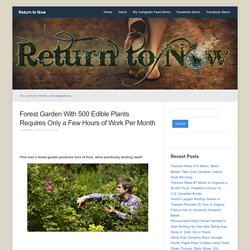
Historically, farms and forests have been at odds. Conventional wisdom says we have to cut down the forest to make way for agriculture. But a growing movement called agro-forestry “capitalizes” on the free services forests provide farmers and gardeners. Geoff Lawton: Permaculture Online. To learn more watch the Permaculture Masterclass, my newest 4-part documentary-style film, here: Forests are ecosystems with a diversity of plants, animals, and fungi.

They were designed by nature to have perfect balance. A food forest is a version of this in which the different, balanced components produce food. When we understand how nature creates its ecosystem, we can model that with productive species to produce food sustainably, with minimum inputs for maximum outputs. Forests have layers. For designed food forests, the plants change from climate to climate. We can plant foods by cultivating the support species at the same time as the fruit trees, then managing the support species to shelter and boost the productive species. So, we are manipulating the way a forest grows, particularly speeding it up, to work in our favor. We can also use animals to help in the process. The Forested Garden: What is a Food Forest? Tour a Thriving 23-Year-Old Permaculture Food Forest - An Invitation for Wildness. Grow a 100-Year-Old Self-Sustainable Food Forest in Your Backyard in Just 10 Years.
Do you dream of a mini-forest in your backyard?
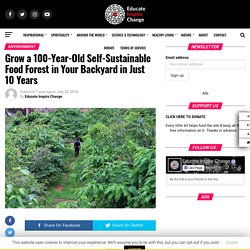
What would you need? A minimum of 100 sq. m. plot. You get a forest at the lowest possible cost- for you and for nature. Give it eight months after planting the saplings, the forest will become so dense that it blocks sunlight from touching the ground. Soon, the forest gets in to a self-sustaining mode – with every drop of rain conserved and every leaf that falls converted into compost. Most of the world we live in today was once forest, our natural habitat for millions of years. Now surrounded by cities and agriculture, humans are no longer living in their “natural” habitat, argues a forest-building engineer named Shubhendu Sharma. But we can recreate little chunks of that habitat in just ten years our own backyards, workplaces and public spaces, he explains in the Ted Talk below: Shubhendu Sharma was an industrial engineer for Toyota hired to offset some of the carbon emissions of the company’s factories.
“We start with soil. Grow a 100-Year-Old Self-Sustainable Food Forest in Your Backyard in Just 10 Years. A forest garden with 500 edible plants could lead to a sustainable future. Forest garden with 500 edible plants takes a few hours of work a month. Working with nature instead of against it, forest gardens promise abundance, as well as the kind of resilience a changing climate demands.
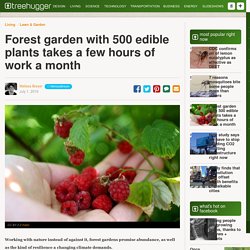
When you think about it, monoculture is just weird. We cover enormous swaths of earth with single crops that deplete the soil, require all kinds of chemicals, wipe out natural habitats and carbon-capturing trees, and whose lack of diversity makes them vulnerable to disease and weather events. And then there's the forest garden. Rather than completely working against nature, forest gardens are designed to mimic natural ecosystems – and guess what? Nature knows how to do things pretty well. A forest garden with 500 edible plants could lead to a sustainable future. Forest, garden, New Zealand, established. Visit a thriving, abundant and very beauitful forest garden planted by Robert and Robyn Guyto 23 years ago near the small town of Riverton at the bottom of New Zealand's South Island.
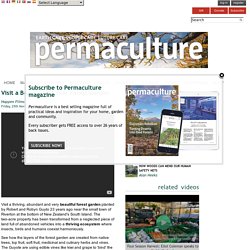
The two-acre property has been transformed from a neglected piece of land full of abandoned vehicles into a thriving ecosystem where insects, birds and humans coexist harmoniously. See how the layers of the forest garden are created from native trees, top fruit, soft fruit, medicinal and culinary herbs and vines. The Guyote are using edible vines like kiwi and grape to 'bind' the native upper canopy together. An interesting idea. They have also cleared the creek, a rubbish dump since Victorian times. Graham Burnett - I've no idea how often this drawing has... Community Fruit Tree and Edible Landscaping Resources. What is an Edible Forest Garden? The Vision of an Edible Forest Garden: "Picture yourself in a forest where almost everything around you is food.

Mature and maturing fruit and nut trees form an open canopy. If you look carefully, you can see fruits swelling on many branches—pears, apples, persimmons, pecans, and chestnuts. Shrubs fill the gaps in the canopy. Plant Guilds - Midwest Permaculture. We teach the fundamentals of plant guild design at every Permaculture Design Certificate (PDC) course we host.Here is our Upcoming Schedule From the Forward of the Plant Guild eBooklet As Midwest Permaculture grew, so did the number of requests from people looking for information and recommendations concerning what plants to add or combine to an existing tree on their landscape to create a useful plant guild.
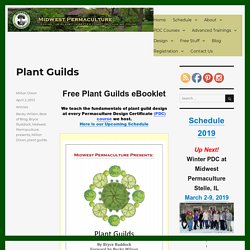
We referred them to Midwest Permaculture’s “Official Plant Guy”, Bryce Ruddock, who chairs the discussions of Plant Guilds on our networking site. Eventually, we asked Bryce to design some foundational guilds as every day examples that would help guide those who are new to permaculture. After he completed these we asked a PDC student of ours, Jesse Tinges, to use his landscape architectural skills to create the sketches.
Food Forests & Plant Guilds in Permaculture Design.